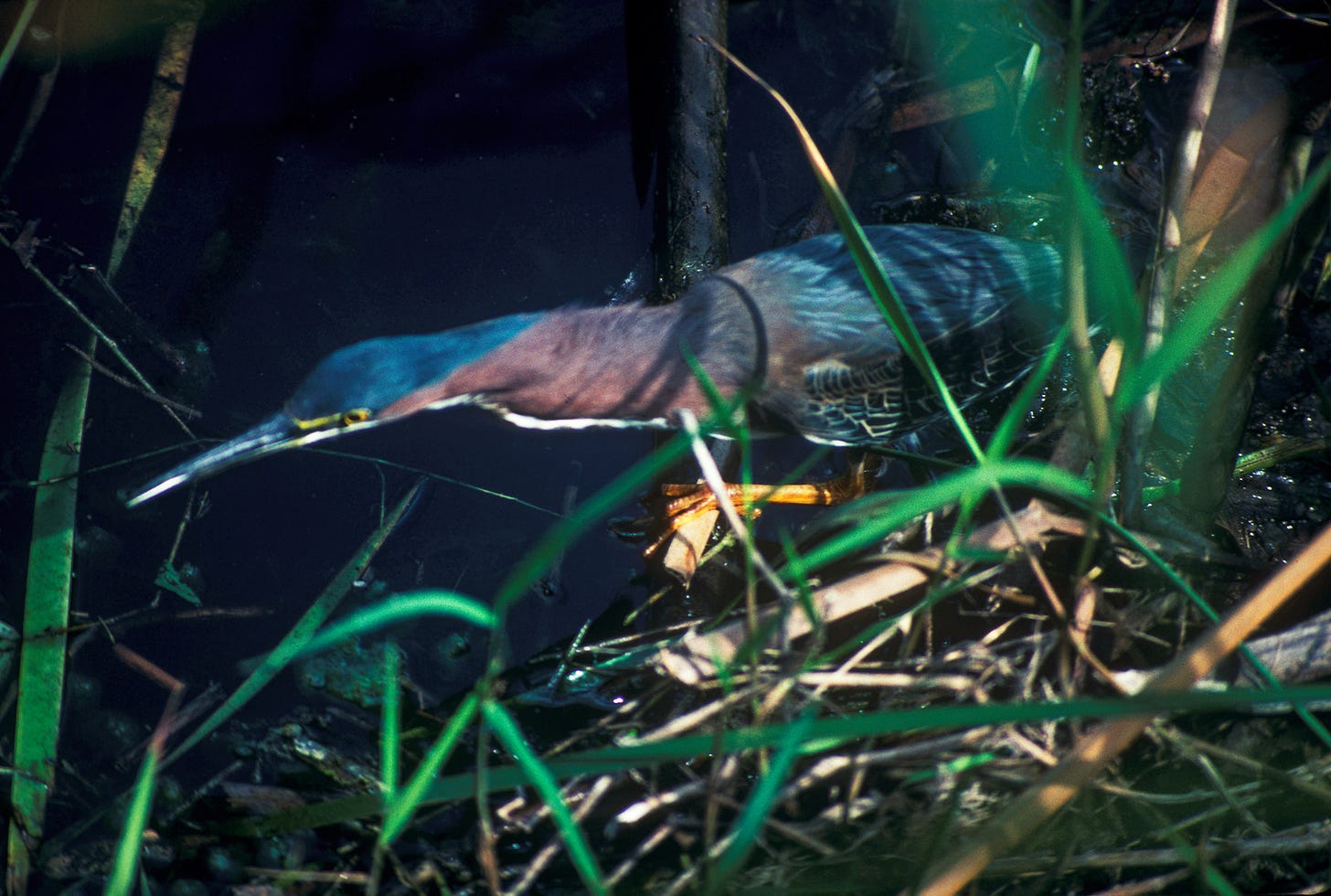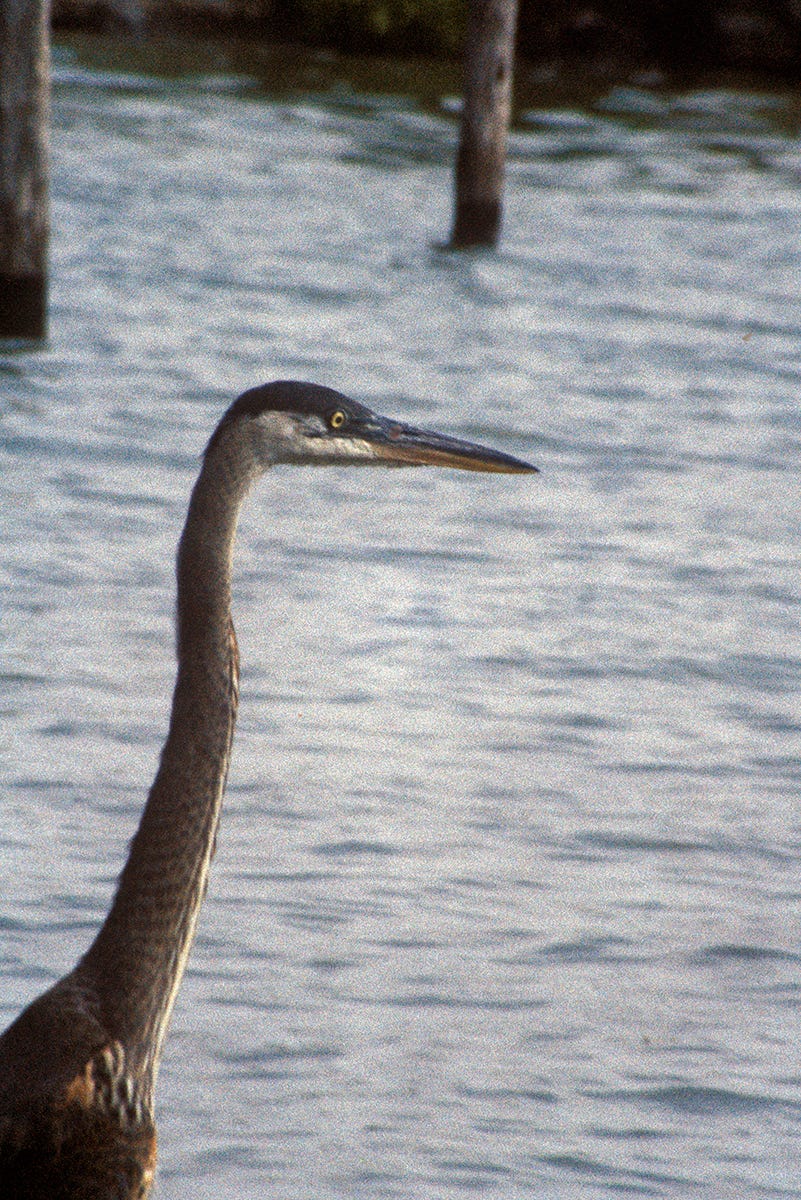Everglades Journal 1991
Green Heron photographed at Everglades National Park by Ray Zimmerman.
Getting There: March 23, 1991
Why should I write a story about the Everglades? Marjory Stoneman Douglas documented it well in her book, The Everglades: River of Grass. She showed the reading public that the Everglades is, in fact, a river. Hundreds of books about the Everglades have appeared before and after her work, including an influential anthology edited by Susan Cerulean.
The Everglades has been celebrated in movies, books, songs, and television series, but those are other people’s stories about this magical land. This essay is my story of a week spent hiking and canoeing in a fragile land cut off from the water supply that is its lifeblood.
An entry in my journal reads, "Anticipation of landing in Miami is unbearable. I hardly slept last night. I hope Everglades is as exciting as I think it will be. I left Chattanooga just as the spring bloom approached its full force. The dogwood trees had yet to bloom, but the redbuds had just opened."
The rest of this story is drawn from my journal but not as direct quotations. I worked at the Chattanooga Nature Center at the time. The trip was their spring break teachers’ workshop. A nature center colleague and ten teachers accompanied me.
When we changed planes at the Atlanta airport with its numerous gates, moving walkways, and baggage cars, I saw all those people going everywhere imaginable and decided that the old saying must be true, "You can get to heaven, but you have to change planes in Atlanta."
As with any time spent in the labyrinths of shopping malls, airports, or office buildings, I had the queasy feeling of being swallowed by a large machine. I feared integration into the Atlanta airport’s technological marvels through some virtual interface. I gladly caught our flight and departed.
The Miami airport was nearly as busy and crowded, so I was happy to see our professional guides greet us at the gate. We loaded our luggage, boarded the van, and were immediately bound for Everglades National Park.
Our guides were young, muscular, tan, and constantly sipping on their water, obeying the dogma of keeping the body and brain well hydrated. I got to know them somewhat over the next few days, although they always maintained professional decorum.
As much as I love the wilderness, I am happy to leave the more athletic aspects of wilderness recreation to others. I am more likely to set up my tent and explore the surrounding area than engage in a fifty-mile backpacking trip or a solo climb up a rugged peak.
Our guides worked for an organization that stated this philosophy. Their brochures repeated it, but I soon realized their interpretation of this description required more vigorous activity than I had anticipated. Many other participants were even less prone to physical activity. This structure for our trip could have led to problems, but we all pitched in with good nature and effort.
Our travels were only beginning when we reached Miami’s bustling airport. We stopped to pick up a canoe trailer, attached it to the van, and drove to Everglades National Park, still a considerable distance away. When we arrived, it resembled a set of toll booths on an expressway. Lights in each lane told the drivers which tollbooths were open. Drivers paid the entrance fees for themselves and their passengers.
We passed through an entry lane for parties with prepaid permits, so our wait was shorter. Once inside the park, we continued four miles to the Royal Palm Visitor Center and stopped to view the exhibits. Dusk was approaching as we walked the Anhinga Boardwalk.
The boardwalk's namesake, an American Anhinga, also known as a water turkey, landed in the grass beside the walkway. It screeched like a banshee, waving its head from side to side. Soon, we observed its swimming behavior, immersed in water with only the neck and head exposed. This is the bird's classic defensive pose. When we returned, the bird sat on a nest in a low bush. Its noisy behavior was an attempt to distract us from the nest.
I was thrilled to see an anhinga for the first time, but the abundant alligators were the main attraction for tourists. One swam near a roosting night heron that neither moved nor gave the crocodilian a passing glance. Perhaps it knew a hungry alligator when it saw one.
I had heard that the distance from an alligator's eye to its nostril in inches was equal to the animal's length in feet. According to my visual inspection from a safe distance, these alligators seemed to conform to this belief. I did not field test this lore with a tape measure.
Back in the van, I noticed the land's dry appearance. It was late March, still the dry season. This day’s Everglades was not the "River of Grass" I expected, with stalks towering above our heads. The grass was shorter than the grasses of the Kansas and Illinois prairies.
The surrounding soil appeared dry from our vantage point in the van, and the grassy growth was brown and dormant. I would later learn that this appearance was deceptive. The aquifer below the surface still held water slowly flowing to the sea. The rock underfoot had a labyrinth of passageways comprising a river beneath the soil.
That night, we checked into our rooms at the Flamingo Lodge. The stucco walls of the lodge were much like those of a motel from 1950, and the lodge provided only basic accommodations.
The all-important air conditioner was more than functional. Cooling the room helped to keep the mosquitoes in check. Our guides stayed in a nearby cabin where we prepared and ate meals.
Great Blue Heron Photographed at Everglades National Park by Ray Zimmerman
A Visit to Mrazek Pond: March 24
We began the next day with breakfast prepared in our guides’ cabin. We learned to prevent mosquitos from entering the cabin by knocking on the door and running to a nearby tree and back. Attracted to our body heat, the mosquitos were left behind when we entered.
Each day, we took turns washing dishes and packed lunches for the day’s adventures. On the first day, the other two men in our group said they needed to stop at the little store, but the guides wanted to get going, so they said we would meet them there after loading the vehicle. We laughed when we saw they had purchased gauzy head nets, but our laughter vanished when the mosquitos descended. We discovered the wisdom of wearing a long-sleeved shirt unbuttoned and untucked. The mosquitos landed on the shirt, too far from the skin to bite.
Then we were bound for a day a Mrazak Pond. On the way there, we saw a white-crowned pigeon. Cars were parked on the side of the road, and the sight of birdwatchers with telescopes alerted us to a rare bird sighting. Long-distance bird watchers may think nothing of jumping on a plane to see a rare bird reported in some distant place. Several had come to see this long-distance flier of the Caribbean. The white-crowned pigeon is not a resident of Florida but sometimes travels there to feed on tropical fruits.
The white-crowned pigeon lacks the impressive talons of a hawk or owl, but bird watchers value it because of its rarity. Some bird watchers travel to Florida solely to view its unique birds. One gentleman allowed us a look through his telescope.
We saw the pigeon just before we reached the pond. The limestone caprock around this pond is incredibly tough but riddled with solution holes. These holes harbor water-loving plants such as scouring rush; Equisetum hymale, a green plant with silicon deposits in its ridged stem. It was once prized for scouring both clothing and cookware. Scouring rush is related to ferns and more closely to the princess pine that covers the floor of undisturbed forests.
One opening provided a home for a spider whose web held a center resembling a flower. The spider lay in wait for a pollinator fooled by its web.
The land around the pond is home to sawgrass and dwarf cypress, although trees closest to the water grow to full size. The sawgrass has a tough leaf with a serrated edge that can cut the unwary traveler. I noted this adaptation that protects the plant from grazing, and I avoided it to protect my legs from its vicious cuts.
I had read of two types of cypress trees that populate the Everglades. Taxonomists once believed the dwarf cypress to be a separate species from the taller cypress found around the open ponds. They are, in fact, simply different growth forms that reflect the abundance or lack of soil and water.
In the sawgrass and dwarf cypress forest, a variety of pink and white orchids bloomed. I did not know the species, but their flower parts included a stamp. The stamp is a part of the flower that rises above the petals. The weight of visiting insects bends the stamp down to deposit pollen on the insect’s abdomens. More examples of unique orchid pollination methods appear on the Sneaky Orchids and their Pollination Tricks page on the Royal Botanical Gardens at Kew website.
After seeing the orchid, we continued our walk to a cypress dome, where a doughnut-shaped hill surrounded open water. As the decaying vegetation accumulated over multiple years, it became soil, and the hillock grew. We heard the squishy mud sounds from our shoes and sank further with each forward step. More water seeped into our shoes each time. When we reached the cypress dome, the soil was high and dry.
Stiff-leaved bromeliads, which looked like miniature pineapple plants, adorned the cypress trees. They were blooming with tiny red sepals and purple petals. They looked pretty under the appropriate magnification of a hand lens.
The center of such cypress domes is generally a 'gator hole, with the opening maintained by a resident alligator. It is home to fish and other water animals during the dry season. The alligator provides them with living space but eats a few fish.
The center of this dome was about nine inches deep, marshy, and choked with aquatic vegetation, indicating no resident 'gator. A tiny fish, likely a mosquito fish, was abundant.
Arrowhead filled the center with notched leaves and brilliant purple flowers, creating a water habitat crawling with dragonfly larvae, predaceous diving beetles, and smaller aquatic insects.
A predaceous diving beetle gained fame in Annie Dillard’s book Pilgrim at Tinker Creek. She watched a frog deflate because the beetle administered a venomous bite laced with digestive enzymes. Like the spider in Charlotte's Web, the beetle sucked up the resulting liquid through its straw-like mouthparts.
Farther into the meadows, we approached a second cypress dome and saw the resident alligator disappear into the water as we got close. Unlike its relatives near the boardwalks and visitor centers, this lively fellow did not remain close by for us to observe. The results of its residence were evident in the open water of the 'gator hole.
At this dome, the stiff-leaved bromeliads were blooming. The cypress trees were draped with Spanish Moss, actually a bromeliad. I could only appreciate the tiny flowers with a hand lens.
I will conclude this journey in my next post.





